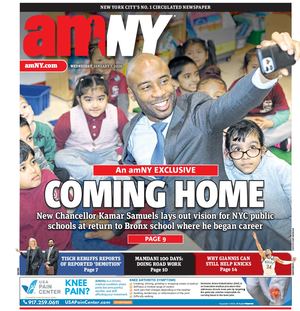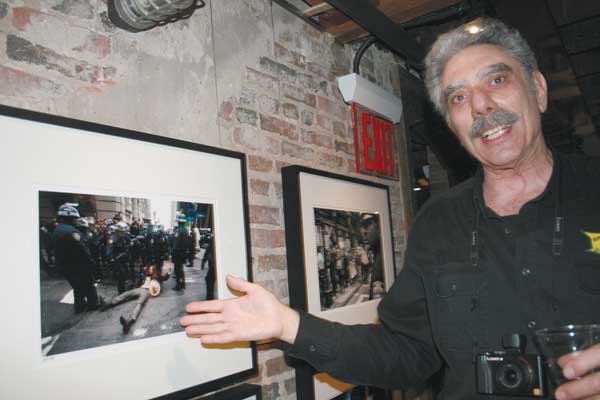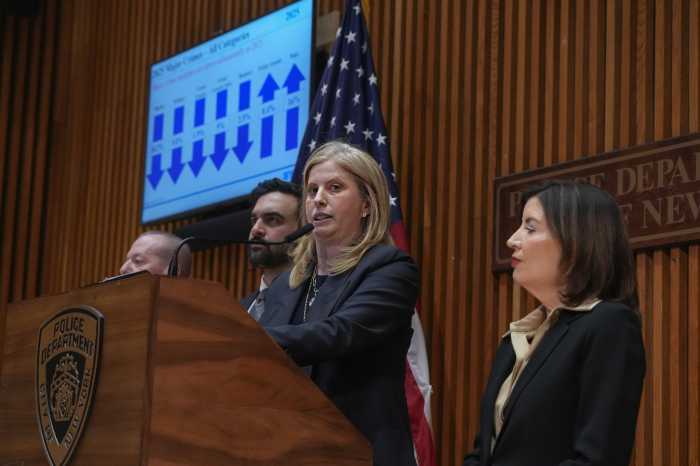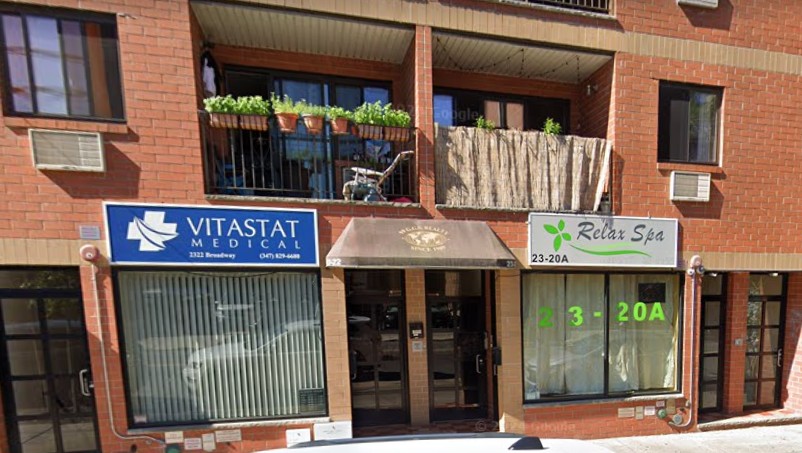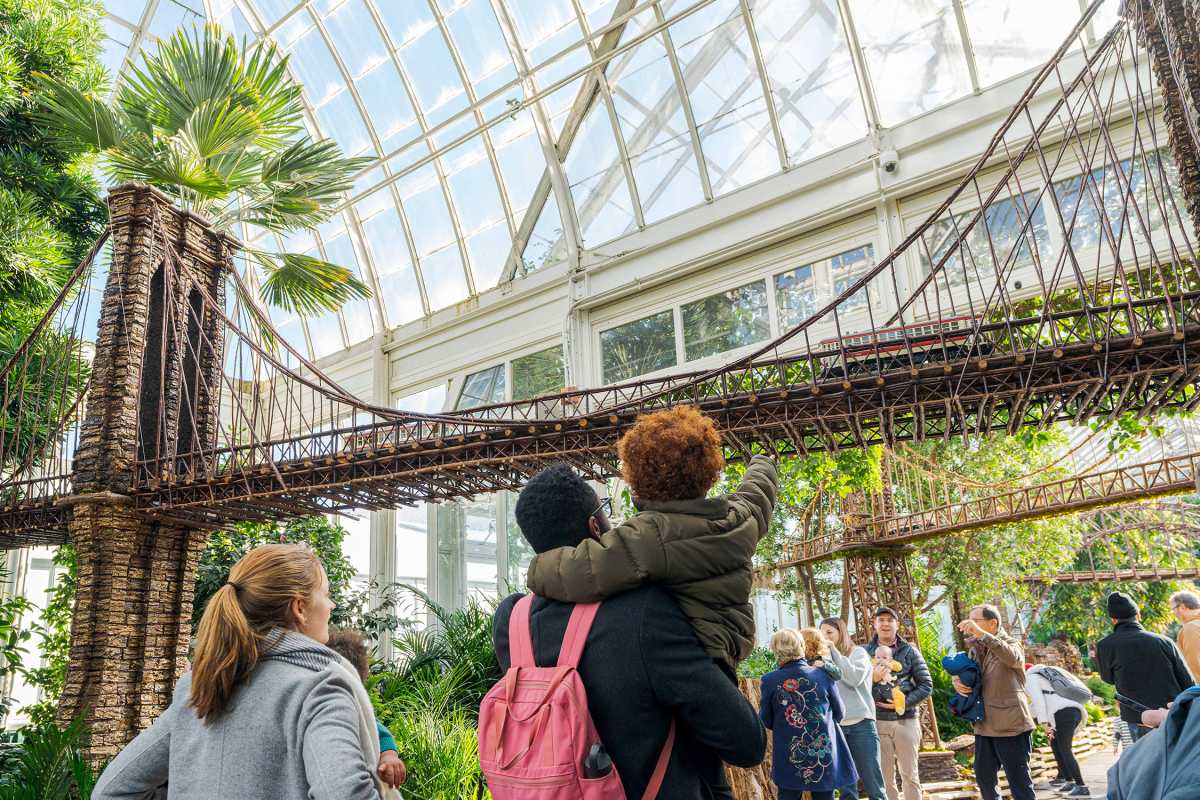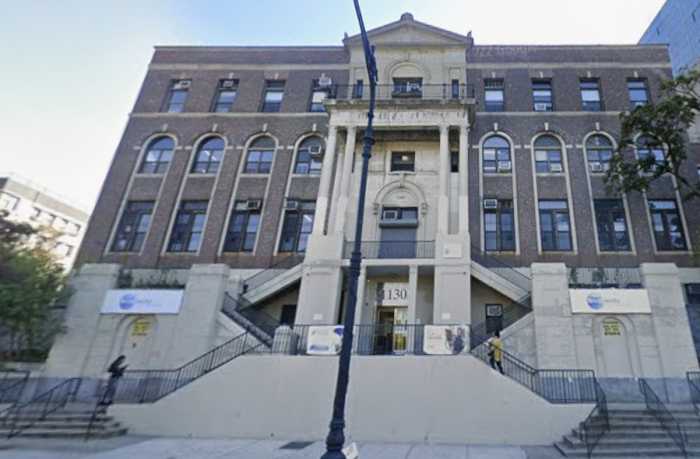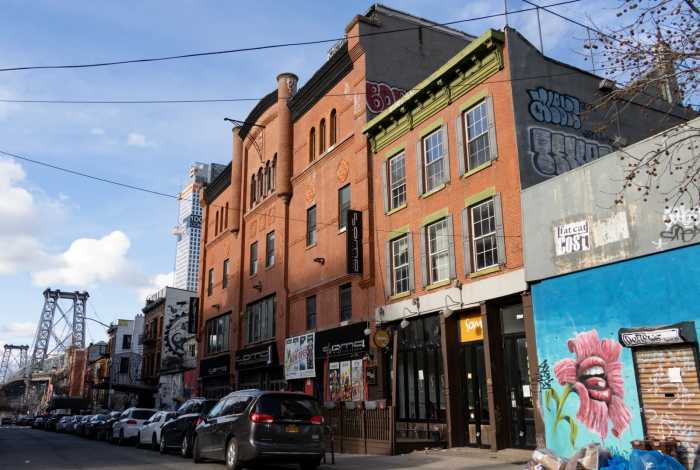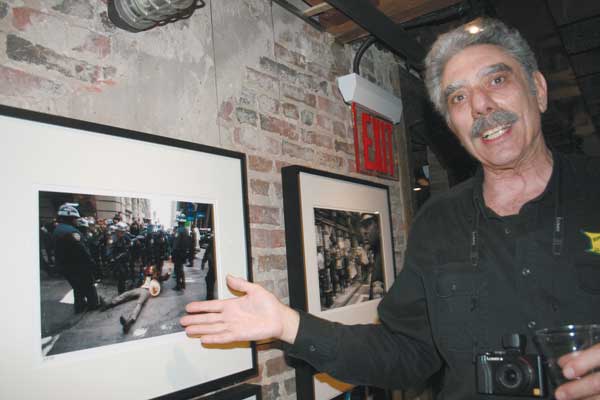 [/media-credit]
[/media-credit]
- Tribeca resident Allan Tannenbaum standing next to his photo of a protester flanked by cops that were arresting him during one of the O.W.S. demonstrations.
BY ALINE REYNOLDS | Hoards of people gathered on the fifth floor of the South Street Seaport Museum last Wednesday, Jan. 25 to observe a piece of history in the making, one in which many of them were contributors.
As part of the maritime museum’s multi-exhibit show celebrating its grand reopening, the museum’s current operator, The Museum of the City of New York, is showcasing 120 color and black-and-white photographs depicting poignant moments of the Occupy Wall Street movement. The collection is a modest sampling of approximately 4,000 submissions M.C.N.Y. curator Sean Corcoran pored over with a team of jurors late last year.
“It was a lot of work just to make people aware we were doing this,” said Corcoran. “But the work really began when the submissions started pouring in.”
In sifting through the entries of the 200 participating photographers, noted Corcoran, the panel looked out for images that illustrated the hallmarks of the O.W.S movement.
“We wanted to capture the broad scope of the movement in the exhibition, and show the diversity and the range of emotion over what happened over those couple of months,” said Corcoran. “Being that [the encampment] was just a few blocks from here, this seems like the right place to think about it.”
Nostalgia overcame patron Alex Toutant, a senior at Oberlin College as he gazed at a photograph of the mass demonstration at Times Square on Oct.15, 2011.
“I was there,” said Toutant. “It’s kind of striking to see it as history now.”
The image of a young, blond-haired girl carrying a sign saying, “Look, Mom, No Future” captivated several patrons including Seaport Museum member and O.W.S. supporter Marcy Brownson, who formerly worked on Wall Street.
“If America is to be who we were and who we say we are,” said Brownson, “we need to be inclusive and we need that little girl to one day look back at that picture and say, ‘You know what, my holding that [sign] made a difference. The world is better now.’”
Williamsburg resident Rebekah Krieger found the exhibit’s famous photograph of bloody-headed 20-year-old demonstrator Brandon Watts to be heart wrenching. While she didn’t personally witness the movement, Krieger, who is jobless, sympathizes with those of the protesters that are unemployed.
“It was one thing to hear [about the protests] on the radio and another thing to see the images,” said Krieger. “The pictures are all hung cheek by jowl, so you really get overwhelmed by the imagery.”
Several of the exhibit’s photographers were present, such as Daily News photojournalist Julia Xanthos. Xanthos, who had daily shifts at Zuccotti Park during the occupation, snapped a photo displayed in the exhibit of Councilmember Ydanis Rodriguez rallying with other protesters on the Brooklyn Bridge to celebrate the movement’s two-month anniversary.
“To watch the park transform into this village was incredible,” she said, “and to be able to be there day-to-day and document the changes was really special.”
The large turnout Wednesday evening was gratifying to Xanthos and the other photographers.
“Normally people these days sit at their computer and click through pictures. It’s beautiful to see people looking, pointing and having conversations about their pieces,” said Xanthos.
Local photographers were on hand as well, such as Community Board 1 member Allan Tannenbaum and Downtown Express’s contributing photographer, Milo Hess. “It’s all wonderful,” said Tannenbaum of the show. “I hope it puts the Seaport Museum on the map.”
“I’m honored, because I’m in the company of such renowned photographers,” chimed in Hess.
In his photo, freelance photographer Andrew Kelly, a resident of the Lower East Side, captured a touching moment of two young O.W.S. protestors embracing as cops conversed behind them. “I thought, for me, that would be the hardest thing to do — to always be watched by the police,” said Kelly. “Because sometimes they’d just make random arrests, and you’d just feel like you were constantly scrutinized.”
In the spirit of O.W.S., photographer Brendon Stuart, who had two photos in the exhibit, set up a makeshift tent in front of the museum during Wednesday’s opening. The tent’s cover comprised a collage of some of the approximately 12,000 photographs Stuart took during the Zuccotti Park occupation.
The tent’s outer design resembled the pattern of the Illuminati pyramid found on the U.S. Great Seal. “It’s a scheme where the bottom of the pyramid represents the 99 percent, the mass of people that don’t have as much power or money; and where the top has all the control and money and power,” explained Stuart.
O.W.S. protester Julio Rolon, a professor in Puerto Rico who was arrested several times in New York and Washington during the fall demonstrations, appreciated the tent. The exhibit, he said, can help spread the word of the movement and enrich people’s understanding of its ideals. “If we actually get the word out there and the people get united,” Rolon said, “we’ll be able to actually stop this greed and this unfairness and injustice in our world.”
That night, all was quiet at Zuccotti Park — quiet enough to hear a pin drop.
